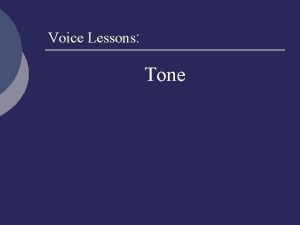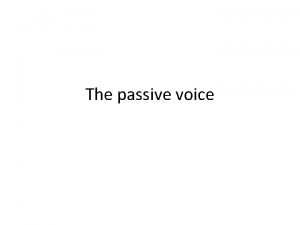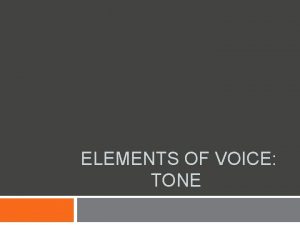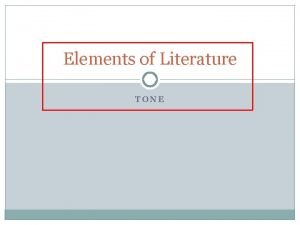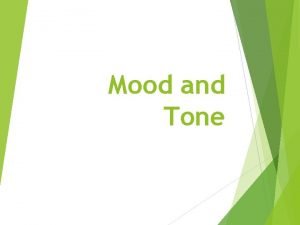Style Voice Tone Literary Elements Style in literature










- Slides: 10

Style, Voice, & Tone Literary Elements

Style in literature is the literary element that describes the ways that the author uses words — the author's word choice, sentence structure, figurative language, and sentence arrangement all work together to establish mood, images, and meaning in the text. Style describes how the author describes events, objects, and ideas.

One easy way to understand literary style is to think about fashion styles. Clothes can be formal and dressy, informal and casual, preppy, athletic, and so forth. Literary style is like the clothes that a text puts on.

The style that an author uses influences how we interpret the facts that are presented. Wording and phrasing can tell us about emotions in the scene, the setting, and characters. If you're still not convinced, consider the differences between the following sentences: He's passed away. He's sleeping with the fishes. He died. He's gone to meet his Maker. He kicked the bucket. The version of that sentence that a writer chooses tells us a lot about the situation, the speaker, and the person being spoken to (the audience).

Tone in Writing Tone in writing is not really any different than the tone of your voice. You know that sometimes it is not “what” you say, but “how” you say it. It is the same with writing. Every adjective and adverb you use, your sentence structure, and the imagery you use will show your tone. The definition of “tone” is the way the author expresses his attitude through his writing. The tone can change very quickly, or may remain the same throughout the story. Tone is expressed by your use of syntax, your point of view, your diction, and the level of formality in your writing.

Tone Continued Examples of tone in a story include just about any adjective you can imagine: • • Scared Anxious Excited Worried Foolish Smart Depressing

Conveying Tone in a Story Tone in writing is conveyed by both the choices of words and the narrator of the story. Consider the tone of The School by Donald Barthelme. Here, words like "death" and "depressing" set a negative or unhappy tone: And the trees all died. They were orange trees. I don’t know why they died, they just died. Something wrong with the soil possibly or maybe the stuff we got from the nursery wasn’t the best. We complained about it. So we’ve got thirty kids there, each kid had his or her own little tree to plant and we’ve got these thirty dead trees. All these kids looking at these little brown sticks, it was depressing.

Choosing Words for Tone In the following excerpt from Edgar Allen Poe’s The Tell-Tale Heart, notice the insane, nervous, and guilty tones. It was A LOW, DULL, QUICK SOUND -- MUCH SUCH A SOUND AS A WATCH MAKES WHEN ENVELOPED IN COTTON. I gasped for breath, and yet the officers heard it not. I talked more quickly, more vehemently but the noise steadily increased. I arose and argued about trifles, in a high key and with violent gesticulations; but the noise steadily increased. Why WOULD they not be gone? I paced the floor to and fro with heavy strides, as if excited to fury by the observations of the men, but the noise steadily increased. O God! What COULD I do? I foamed -- I raved -- I swore! I swung the chair upon which I had been sitting, and grated it upon the boards, but the noise arose over all and continually increased. It grew louder -- louder!

In Hemingway’s A Clean, Well-Lighted Place the tone is calm and peaceful. It was very late and everyone had left the cafe except an old man who sat in the shadow the leaves of the tree made against the electric light. In the day time the street was dusty, but at night the dew settled the dust and the old man liked to sit late because he was deaf and now at night it was quiet and he felt the difference.

Voice Think about the last time you read an email from a friend. Could you almost “hear” that friend talking to you? Perhaps the email contained phrases your friend often uses, or expressed an attitude that is typical of him or her. This is the VOICE.









